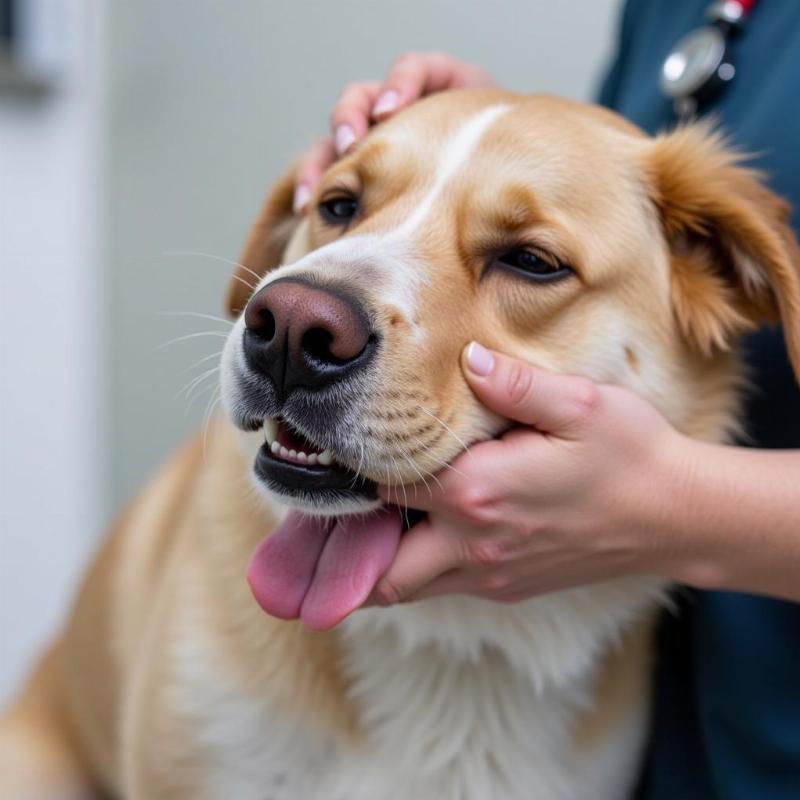If your dog ate a pork bone, you’re likely worried. This is a common concern for dog owners, and knowing how to react can make all the difference. While some bones can be okay for dogs, pork bones, especially cooked ones, pose significant risks. This article will guide you through the potential dangers, what signs to watch for, and what steps to take if your dog has ingested a pork bone.
Dangers of Pork Bones for Dogs
Pork bones are dangerous for dogs primarily because they splinter easily, especially when cooked. These sharp fragments can cause a variety of problems, ranging from mild irritation to life-threatening injuries.
Common Problems Caused by Pork Bone Splinters
- Mouth and Throat Injuries: Splinters can get lodged in your dog’s gums, tongue, or throat, causing pain, bleeding, and difficulty swallowing.
- Gastrointestinal Blockages: Bone fragments can obstruct the digestive tract, leading to vomiting, constipation, or a potentially fatal blockage requiring surgery.
- Perforation of the Stomach or Intestines: Sharp bone pieces can puncture the stomach lining or intestines, causing internal bleeding, infection, and peritonitis (inflammation of the abdominal lining).
- Pancreatitis: The high fat content in pork bones can trigger pancreatitis, a serious and painful inflammation of the pancreas.
Signs Your Dog Needs Veterinary Attention
If your dog ate a pork bone, monitor them closely for the following signs:
- Vomiting
- Diarrhea (possibly bloody)
- Loss of appetite
- Lethargy
- Whining or other signs of abdominal pain
- Straining to defecate or inability to pass stool
- Excessive drooling
- Pawing at the mouth
- Changes in behavior, such as restlessness or aggression
If you observe any of these symptoms, seek immediate veterinary care.
What to Do if Your Dog Ate a Pork Bone
Immediate Actions
- Do not induce vomiting: This can cause further damage as the bone fragments move back up the esophagus.
- Contact your veterinarian immediately: Explain the situation and follow their instructions.
- If directed by your veterinarian, feed your dog a bulky meal: This can sometimes help cushion the bone fragments and aid in their passage through the digestive tract. Bread or plain cooked rice are good options.
At the Veterinary Clinic
Your veterinarian will likely perform a physical exam and may recommend diagnostic tests such as X-rays or ultrasound to assess the location and potential damage caused by the bone fragments. Treatment will depend on the severity of the situation and may include:
- Monitoring: If the bone fragments are small and your dog is showing no symptoms, your vet might recommend close monitoring at home.
- Endoscopy: A flexible tube with a camera can be used to retrieve bone fragments from the esophagus or stomach.
- Surgery: In cases of intestinal blockage or perforation, surgery is often necessary to remove the bone fragments and repair any damage.
 Dog being examined at the veterinary clinic
Dog being examined at the veterinary clinic
Preventing Your Dog from Eating Pork Bones
The best way to avoid the dangers of pork bones is prevention.
- Never give your dog cooked pork bones: These are especially prone to splintering.
- Supervise your dog carefully during meals and when outdoors: Make sure they don’t have access to discarded pork bones or scraps.
- Train your dog to “leave it” or “drop it”: These commands can be invaluable in preventing them from picking up dangerous objects.
- Provide safe chew toys: Offer a variety of appropriate chew toys to keep your dog occupied and satisfied.
Conclusion
If your dog ate a pork bone, swift action is crucial. While not all cases result in serious complications, the potential for injury is significant. By understanding the risks, recognizing the signs of trouble, and taking appropriate steps, you can help protect your furry friend from the dangers of pork bones.
FAQ
- Can I give my dog raw pork bones? While raw bones are generally less likely to splinter than cooked bones, they still pose risks, including bacterial contamination and potential damage to teeth. It’s best to avoid giving your dog any type of pork bone.
- What should I feed my dog instead of pork bones? There are many safe and healthy chew toys available, including those made of nylon, rubber, or rawhide (under supervision).
- How long does it take for a bone to pass through a dog’s digestive system? This can vary depending on the size and type of bone, as well as the individual dog. It can take anywhere from a few hours to several days.
- What are the signs of pancreatitis in dogs? Signs can include vomiting, diarrhea, loss of appetite, lethargy, abdominal pain, and fever.
- Is it okay to give my dog ham bones? No, ham bones, like other pork bones, are dangerous for dogs.
- What if my dog only ate a small piece of pork bone? Even small fragments can cause problems. Monitor your dog closely and contact your veterinarian if you notice any unusual symptoms.
- My dog seems fine after eating a pork bone. Should I still be concerned? Yes, it’s important to contact your veterinarian even if your dog seems fine. Internal damage may not be immediately apparent.
Beautdogs.us is your premier resource for all things dog-related in the US. We offer expert advice on dog breeds, care, and products, catering to both new and experienced dog owners. We strive to be your trusted source for comprehensive and engaging information on canine companionship and well-being. Contact us today to learn more! Email: [email protected], Phone: +1 501-555-7529 or visit Beautdogs.us.